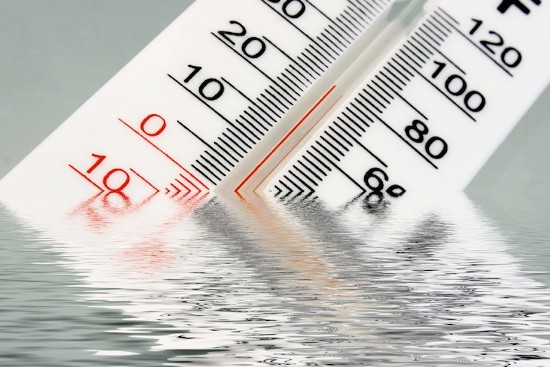A study published this month in Advances in Atmospheric Sciences states that the world’s oceans set new record high temperatures last year. Why is this happening? Because heat-trapping greenhouse gasses (GHGs) emitted from human sources have raised the atmosphere’s mean temperature by 1.1 Celsius (almost 2 Fahrenheit) degrees since the Industrial Revolution, and there appears to be no end in sight to this rise. And because more than 70% of the Earth’s surface is the ocean, the heat increase in the atmosphere is bound to alter the temperature of the ocean surface.
You can test this hypothesis yourself on warm days next to bodies of water where the shallows warm rapidly because of the interaction between warmer air and surface water. How much of the GHGs heat-trapping gets absorbed by the oceans of the world? The number is an astounding 90% and since 1958, the year the first comprehensive studies began, ocean temperatures have been rising. And since 1990, the rise is accelerating.
When ocean surface waters get warmer, a number of phenomena occur.
- Ocean heat contributes to extreme weather event increases. Hence more intense tropical storms and rain contribute to flooding (see California over the past few weeks).
- Ocean heat causes thermal expansion which raises sea levels contributing to increases in surface flooding and seawater intrusion into inland aquifers in low-lying coastal areas.
The study notes that there is “an energy imbalance in the earth’s climate system” brought on by anthropogenic GHGs. It goes on to describe the ocean-atmosphere interaction creating “thermal inertia to sea surface temperatures” that exert “considerable control over the world’s weather.” The end result is more water vapour in the atmosphere. That means changes to precipitation patterns, salinity and surface water density.
The more ocean water warms the more evaporation occurs. More evaporation means increases in ocean salt content. At the same time, more evaporation causes rainfall which dilutes surface water making it less saline. These more and less saline anomalies are becoming more noticeable, and although ocean circulation tends to even things out, nonetheless, the salinity variability in ocean surface waters is on the increase.
The combination of warmer temperatures and increased salinity is impacting the natural stratification pattern within the ocean water column that runs from the surface to the seafloor. The vertical movement of water from the surface to the sea bottom provides a critical exchange for carbon, oxygen, food, and other important factors contributing to the health of ocean ecosystems and the stabilizing of Earth’s climate. The study reports that since 1958 the upper 2,000 metres (approximately 6,500 feet) of the ocean has seen a significant rise in temperature.
There are regional hotspots.
- The Indian Ocean has been showing rapid warming since 2000.
- The tropical Atlantic Ocean where hurricanes originate is also warming faster than the global average.
- The same is true of the North Atlantic since the late 1950s.
- The Blob, a recent phenomenon that occurred in the North Pacific Ocean is an indicator of large-scale persistent warming leading in recent years to intensive heat waves in Western North America. The Blob has also caused areas of the North Pacific to suffer from deoxygenation in the water column threatening marine life.
- Even the Southern Ocean that rings Antarctica has exhibited a warming trend since the 1950s.
In its conclusions, the study states, “The global long-term warming trend is so steady and robust that annual records continue to be set with each new year.” The rise is creating further imbalances in the world’s climate let alone stressing ocean health through changes in salinity, stratification imbalances, and oxygen exchange with implications for sea life.
This is an unprecedented study with contributions from researchers at universities and within the national administrative bodies of their respective countries responsible for studying the ocean and atmosphere. Four nations contributed to the data gathering and analysis, China, the United States, New Zealand, and Italy. Data collected came from the World Ocean Database supported by the Argo network, SeaDataNet, and remote sensing satellites.










[…] what humans write. Knowing this I had to try it out. So I asked ChatGPT to take on a subject from a posting I wrote yesterday I said “explain the relationship between atmospheric warming and rising ocean […]
There are other reasons for global warming that don’t get mentioned.
1. Deforestation is out of control, even more so since the industrial revolution period. It messes with moisture levels, the carbon sink, removes shade to cover the ground that cools and protects top soil etc, removes large ecosystems that depend on specific tree species, removes wind barriers that results in dust bowls.
2. Abusing the planet like a toxic chemical dumpster. Throw dangerous industrial waste in a pit, ocean or burn it like a caveman.
3. Popping off atomic bombs (about 2000+ since 1945).
4. Volcanoes erupting gas, heat and fine ash into the atmosphere. Nothing messes with weather like a volcano can.
5. We are still coming out of the last ice age, we are now heading into a solar springtime. Alaska used to be green tropical, it will again when the solar summer returns. Eventually the ice age will return with the next solar winter period. Short seasonal cycles in larger solar cycles.
Humans are a bit arrogant regarding weather patterns, meteorology records only go back 200 to 250 years ago. The rest is fudged math from core samples and overpaid faceless “experts”.
In saying that, humans are not helping, however, man can’t stop the tide. Nature will turn on our arrogance. Time to fix the damage we have inflicted for so many centuries with no rest between. We are all home wreckers trashing our only home like madmen.